Product Description
PS: Please kindly send us exact technical requirments so that we can recommend you the best solution. Thanks for your understanding!
General Description
Mercury slip ring enjoys the same performance just like other electrical sliprings, both of them are a device which could provide 360 degree rotations to transmit signal and power between stator side and rotor side of different industry equipments. No doubt, mercury slip ring just take advantage of mercury contact as a conductive media, which only could transfer current and signal via liquid metal under normal temperature status. This kind of slip ring has the main feature of strong stability, high precious signal and no noise. Meanwhile, compared with the traditional mechanical sliprings, this mercury rotary connector is smaller size, earlier installation and free maintenance, etc. Mercury slip rings provide the most scientific, economical and profitable rotary solution for various application industries.
Features:
1.High work speed & big current.
2.Less than 1mΩ contact resistance, no noise.
3.Compact structure, easy installation and smooth operation.
4.Free maintenance and more durable than traditional slip ring.
5.Apply to any rotating device to transmit various signal and power.
6.Non-mercury slip ring is optional ( Conform to CE, RoHs certification ).
7.Stainless steel and aluminum alloy housing is optional.
8.Contact pin and lead wire installation is optional.
Application:
1.Rotating table, rotating camera and ratary lamp box.
2.Cable wheel, winding machine.
3.Resistors cutting machine.
4.Robot arm.
5.Wind turbine generator.
6.Medical equipment, spinning LED CZPT board.
7.Manufacturing and handling control machine.
Notices:
1.Not exceed the max temperature 60ºC(140°F ), ambient temperature + self heating.
2.Vertical mounting and storage should keep the U P in the up direction.
3.Mounting into a shaft should keep no eccentricity.
4.Do not solder on the connector and terminal.
5.Connect the connector on the terminal only a few times, losing connection will cause heating when apply electrical power.
6.Vibration will cause service life shorter.
7.The rotary connector can be mounted by the body or plastic collar, but it can not carry mechanical loads. Another end should be connected floating hold by electric wire.
8.The uppers notice should be kept, otherwise, it will cause the rotary connector failure or shorten service life.
Specification:
| Product Model | A3S |
| Circuits & Current | 3 Circuits @ 4A |
| Voltage Rating | 250VAC/DC |
| Max Frequency | 200MHz |
| Max Work Speed | 1800RPM |
| Work Temperature | -30ºC~+60ºC |
| Torque | 100gm |
| Remarks: Transferring micro voltage, current, EMF,thermocouple,strain gauge, audio, video,high frequency signal,etc. |
Drawing:
Highly apprecaited for your support and interest. Welcome your consulting and contacting!
| Certification: | ISO9001, RoHS, CE |
|---|---|
| Transmission Medium: | Mercury |
| Circuits: | 3 Circuits |
| Current Rating: | 4A |
| Work Speed: | 1800rpm |
| Voltage Rating: | 250VAC/DC |
| Customization: |
Available
| Customized Request |
|---|
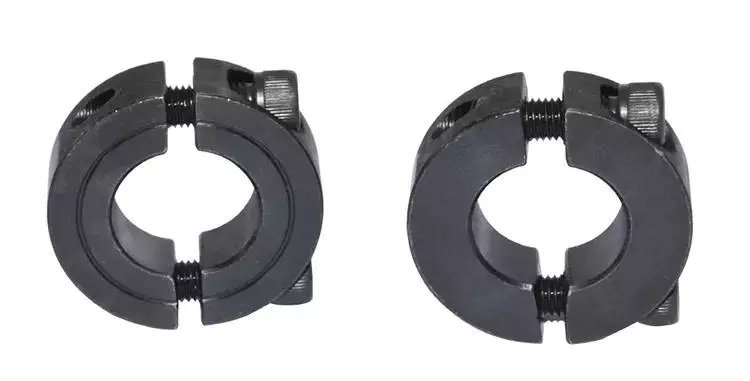
Choosing a Shaft Collar
The shaft collar is a simple machine component used in a variety of power transmission applications. They are most often found on gearboxes and motors. Their simple design makes them an easy component to install and remove. Among other uses, shaft collars are used as bearing faces, mechanical stops, and locating components.
Clamp-style shaft collars
Clamp-style shaft collars fix many of the problems associated with set-screw collars. Available in two-piece and one-piece designs, these collars compress the shaft and lock into place. This allows for a uniform distribution of force on the shaft. Clamp-style shaft collars provide more holding power than set-screw collars, but they work best under consistent pressure. Clamp-style shaft collars also work better against negative forces, as they have a separate, un-tightened side.
Clamp-style shaft collars feature mounting holes in the outer diameter. Like clamp-style collars, mountable shaft collars can be installed on adjacent assemblies, but the mounting method does not affect holding power. Mountable shaft collars are commonly used in mounting sensor brackets. They may have rounded or flat outer diameters to accommodate the mounting process. Mountable shaft collars may also have tapped or flat holes to facilitate installation.
Quick-clamp shaft collars have the same functionality as clamp-style collars, but feature a removable lever. They are typically quick-to-install and do not mar the shaft. Quick-clamping collars are especially beneficial in applications that require light-duty torque. They also make for quick and easy adjustments.
Heavy-duty shaft collars feature larger outer diameters, a wider face, and a larger screw. These collars are ideally suited for d-shafting and can offer greater holding power than set-screw collars. These collars are typically manufactured from high-strength 2024 aluminum.
Clamp-style shaft collars can be used in many different applications. They can be used for a variety of applications, including bearings, and are especially suited for rotary machines. However, there are some drawbacks. While they may not be as flexible as set-screw collars, they can still perform well under constant loads. One drawback is that they tend to loosen under shocks and reduce the holding power of clamping hardware.
Another advantage of clamp-style shaft collars is that they do not mar the shaft and allow for easy positioning adjustments. Furthermore, they are easier to install and offer greater holding power than set-screw collars. These collars are made from high-quality materials with tight tolerances and are available in different bore sizes.
Clamp-style shaft collars are the most common type of shaft collars. They can be two-piece or one-piece. Among these, two-piece collars are the most convenient option. One-piece collars are hard to move, and two-piece collars have a hinge on one side and a clamp-style collar on the other side.
The materials used in Clamp-style shaft collars play a crucial role in their overall performance. They should be strong, corrosion-resistant, and have good holding power. They should also be able to withstand high temperatures. The most common materials used for shaft collars are steel and aluminum. Some types are made from stainless steel, while others are made from engineered plastic.
Clamp-style shaft collars can come in two pieces or single-piece designs. The smaller one-piece collars usually have a back-cut opposite the clamp cut, which reduces the cross-sectional area at the hinge point. This reduces the amount of force required to clamp the collar, which makes it easier to use stronger screws.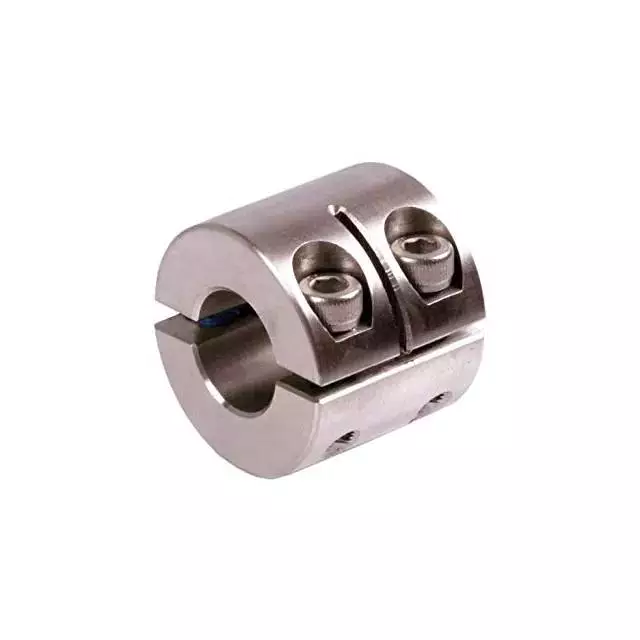
Aluminum, carbon steel, and stainless steel shaft collars
When choosing a shaft collar, you should consider the material it is made of. You can purchase collars made of carbon steel, aluminum, or stainless steel. Each of these materials has its benefits and disadvantages. Steel is more durable than aluminum and tends to provide better holding power. Aluminum, on the other hand, is lighter and has a favorable strength-to-weight ratio. The material you choose should depend on your specific needs, such as corrosion resistance or weight.
Mountable shaft collars are used to mount sensors, fixtures, and other assemblies. These collars are available with outer diameter holes, flats, or quick-release designs. The material used to make these collars varies, with standard models made of 1215 lead-free steel and 2024 aluminum.
When choosing shaft collars, take into account the material and surface treatment. Different materials offer different properties, which will determine the performance of the collar. In addition to material, each shaft collar comes with a different holding power. Holding power is a key factor in choosing a shaft collar because it determines the amount of load it can withstand without slipping. The holding power depends on the screw size, the bore size, and the bulk of the collar.
Aluminum, carbon steel, and stainless steel shaft-collars can come in various styles. CZPT, for example, offers standard shaft collars in hex and d-bore profiles. Hex collars provide extra holding power and are better than set screws. Additionally, they do not mar the shaft and provide a better grip.
Another type of shaft collar is the quick-clamp shaft collar. These features allow users to install and remove them with ease. The quick-clamp collar has a handle that allows the user to quickly adjust it. While these shaft collars are designed for light duty applications, they are not recommended for heavy-duty or high-RPM applications.
Shaft collars are simple yet versatile components. They are used for various applications, including mechanical stops, stroke limiters, and retainers. They can also be used to align and space other components. Shaft collars are widely used in gearbox assemblies, flagpoles, and medical instruments, among others.
Two-piece shaft collars offer the same benefits of one-piece shaft collars, but offer additional convenience and versatility. They are easier to install and disassemble, reducing installation and labor costs. They also offer superior holding power. They also feature a threaded bore that acts as a positive mechanical stop when the shaft is rotated.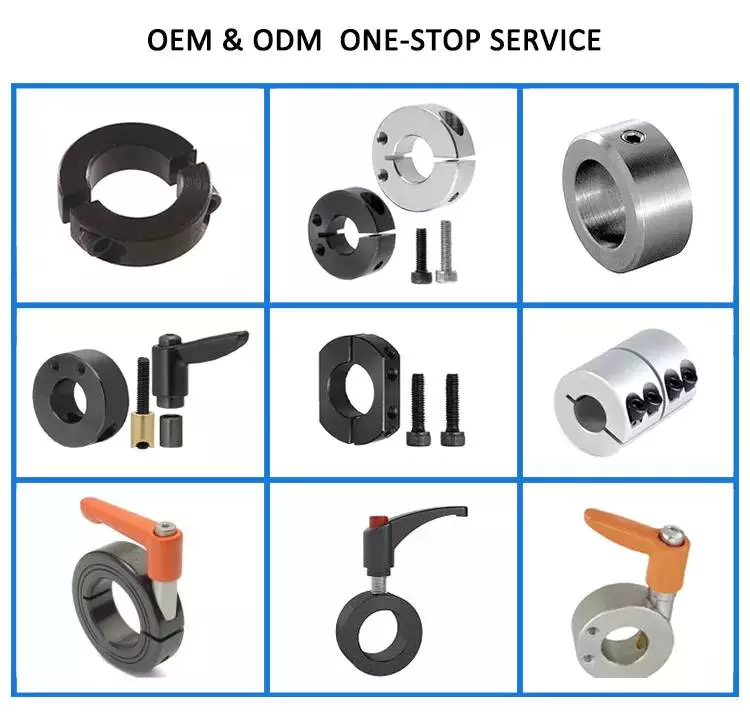
Over-torqueing shaft collars
Shaft collars are often used to secure components on shafts or other surfaces. They also provide an easy way to adjust the positioning of motor assembly components. Many different types of shaft collars are available to meet the specific needs of different applications. These include round, hexagonal, square, and D-bore collars.
The design of shaft collars must account for the load they will support. Some collars are made of metals, while others are made of plastic or composite materials. Typically, shaft collars are made of steel, but can also be made from aluminum or alloyed steel. Some are coated with zinc.
Shaft collars are available in one-piece and two-piece designs. Single-piece collars are designed to fit securely around a shaft, while double-piece collars allow for greater clamping force. These collars can be assembled anywhere along the shaft and can be installed between two pieces. They are available in different bore configurations and can be customized to meet your specific application.
Clamp style collars are easy to install and disassemble, and have a larger holding force than one-piece collars. These collars are also more shock-load resistant. They also don’t mar shaft surfaces, unlike setscrews. They can also be easily adjusted without damaging the shaft. Another style of collar is the quick-clamping style. This type of collar doesn’t mar the shaft, and is easily installed and removed without tools. These are best for light-duty applications.
When choosing a shaft collar, you should consider the tolerance of the shaft. It is important to select a shaft with a tight tolerance. The shaft’s hardness should not be greater than Rockwell C35. A wide tolerance will affect the holding power of the collar. If the shaft is undersized, you may need to use a screwdrive to slide the collar on the shaft.
Shaft collars are a versatile component with many different applications. They can secure industrial railings or serve as positioning devices in medical equipment. They are also widely used in automation machinery. They are used to protect cylinders and actuators and to ensure alignment between components. For this reason, they are very versatile and adaptable.
Clamp-style collars work well under constant loads, but they may need assistance during impact loads. Shock loads can be difficult to avoid, especially if the mass is small. Clamp-style collars with an undercut in the shaft help to resist the impact of shock. Moreover, they offer positive stops in both axial directions.
Clamp-style shaft collars are a good alternative for set-screw collars. They are easy to install and prevent shaft damage. They also come with an added advantage of being easy to adjust. Clamp-style shaft collars have double the holding power of set-screw collars.
In addition to holding components, shaft collars can also function as spacers and limit shaft movement. They are essential for many applications. They are commonly used in motors and gearboxes to ensure correct positioning for power transmission. They are also used to control shaft movement in reciprocating applications.

editor by CX 2023-11-11
China supplier 40mm to 100mm 1/4 to 4 Inch Set Screw Double Split Shaft Clamp Collar for Bearing Mounting browning shaft collar
Product Description
| Certification | ISO9001:2018;SGS;TS16949 |
| Quality |
CNC machine, CNC Turning, CNC Milling, CNC center machine, auto lathe machine, Wire-cutting Machine CNC punching machines, CNC bending machines CNT stamping machine, CNC/auto lathe machine, Drilling machine, Hydraulic machine, Riveting machine, Tapping machine, welding machine, Film attaching machine, etc. |
| Materials |
Aluminum, Steel, SPCC, SGCC,SECC, SPTE, Stainless steel, Brass, Copper, Bronze, ABS, PC, PO, POM, Nylon, etc. |
| Surface finish |
Anodized, Oxide, Plating, Brushing, Polishing, Blackened, Powder coating, Sandblasting, Laser engraving Zn-plating, Ni-plating, Cr-plating, Tin-plating, copper-plating, the wreath oxygen resin spraying, the heat disposing, hot-dip galvanizing, black oxide coating, painting, powdering, color zinc-plated, blue-black zinc-plated, rust preventive oil, titanium alloy galvanized, silver plating, plastic, electroplating, anodizing, etc |
| Inspection Equipment |
CMM, Projection, Calipers, Micro caliper, Thread Micro caliper, Pin gauge, Caliper gauge, Pass meter, Pass meter, etc. |
| Drawing formation | PDF, CAD/DWG/DXF, IGS/STP etc. |
HangZhou CZPT Industrial Co., Ltd. is a comprehensive factory that specialized in fasteners, CNC parts, stamping parts, machinery parts, and so on. Since the establishment of the company, we have passed ISO9001: 2018, SGS, TS16949.
Our factory covers an area of 5,000 square CZPT and has 58 employees, including 5 R & D personnel and 5 quality inspection personnel.
Major areas of service include automotive, bicycle and motorcycle, industrial automation, agricultural equipment, digital electronics, medical equipment, and so on.
Looking CZPT to your cooperation.
1. We have Specialized QC testers to check the products quality according to customers’ needs.
2. We have IQC to check the dimensions and surface of the incoming material.
3. We have PQC to inspect full-course during the processing.
4. We have FQC to inspect all the plating products from outsides and make the 100% inspection before the shipments.
FAQ:
Q1: Why choose ZheJiang n?
To provide our customers with first-class services in the supply of quality screws minimizing costs.
Q2: How is quality ensured?
All our processes strictly adhere to ISO9001:2018 procedures. We have strict quality control from producing to delivery. Our company had strong technology support, 80% of our colleagues are master or bachelor’s degree. We have cultivated a group of managers who are familiar with product quality , good at modern concept of management.
Q3: Can You Strictly Follow The Tolerance on The Drawing And Meet The High Precision?
Yes, we can, we can provide high precision parts and make the parts as your drawing.
Q4: How should I order and make payment?
By T/T, for samples 100% with the order; for production, 30% paid for deposit by T/T before production arrangement, the balance to be paid before shipment. negotiation accepted.
Q5: What’s your Delivery Time?
Standard parts: 7-20days
Non-standard parts: 15-25days
We will make the delivery as soon as possible with the guarantee quality
Q6:How to Custom-made (OEM/ODM)?
If you have a new product drawing or a sample, please send to us, and we can custom-made the as your required. We will also provide our professional advices of the products to make the design to be more realized & maximize the performance.
Q7:Which mode of transport would be better?
In general, the product are heavy, we advice to make delivery by sea, Also we respect your views of other transportation as well.
| Standard Or Nonstandard: | Standard |
|---|---|
| Shaft Hole: | 8-24 |
| Torque: | >80N.M |
| Bore Diameter: | 19mm |
| Speed: | 8000r/M |
| Structure: | Rigid |
| Samples: |
US$ 20/Piece
1 Piece(Min.Order) | |
|---|
| Customization: |
Available
| Customized Request |
|---|
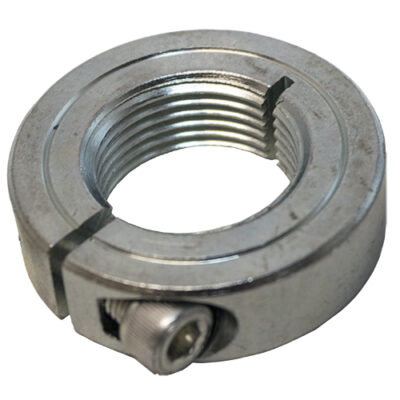
What are the temperature resistance properties of split collars?
The temperature resistance properties of split collars vary depending on the material they are made from. Here’s a general overview of temperature resistance for common split collar materials:
- 1. Steel Split Collars: Steel split collars can generally withstand a wide range of temperatures. Standard steel split collars are suitable for temperatures from -40°C to 250°C (-40°F to 482°F). For higher-temperature applications, heat-resistant steel alloys may be used.
- 2. Aluminum Split Collars: Aluminum split collars have a temperature resistance range of approximately -40°C to 150°C (-40°F to 302°F). They are lighter than steel but may not be suitable for extremely high-temperature environments.
- 3. Stainless Steel Split Collars: Stainless steel split collars are highly corrosion-resistant and can endure a wide temperature range. They are suitable for temperatures from -100°C to 300°C (-148°F to 572°F) and often used in harsh environments.
- 4. Plastic Split Collars: The temperature resistance of plastic split collars varies with the type of plastic. Common plastics like nylon and acetal have a range of -40°C to 80°C (-40°F to 176°F). Some specialty plastics offer higher temperature resistance, up to 150°C (302°F).
- 5. Industry-Specific Materials: In some industries, specialty materials with enhanced temperature resistance are used. For example, aerospace applications may require split collars made from materials capable of withstanding extreme temperature fluctuations encountered during flight.
- 6. Coatings and Treatments: In addition to the base material, coatings and treatments can improve the temperature resistance of split collars. For example, heat-resistant coatings can extend the upper temperature limit.
It’s important to consult the manufacturer’s specifications for specific split collar products to determine their exact temperature resistance properties. When selecting split collars for applications in extreme temperature conditions, consider not only the collar material but also factors like the duration of exposure and the presence of additional heat-resistant treatments.
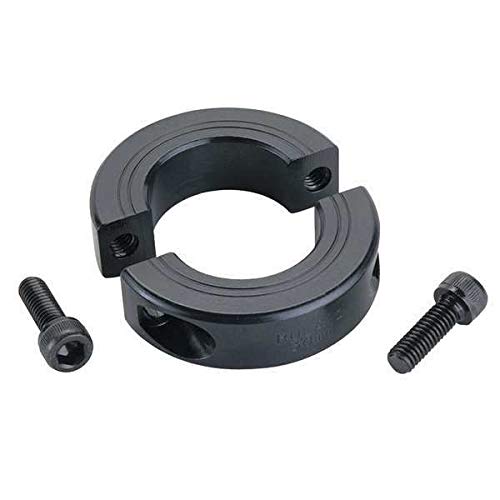
Where can I purchase split collars with specific certifications for certain industries?
Purchasing split collars with specific certifications for particular industries is crucial to meet safety and regulatory requirements. Here are some sources where you can find certified split collars:
- 1. Industrial Suppliers: Many industrial suppliers and distributors offer a range of certified split collars designed for specific industries. These suppliers often have a variety of certifications to meet regulatory standards.
- 2. Manufacturer Websites: The official websites of split collar manufacturers typically provide information on certified products. You can directly contact manufacturers to inquire about certifications and place orders.
- 3. Specialized Industrial Stores: Some specialized industrial stores focus on specific industries, such as aerospace or medical. These stores are likely to carry certified split collars tailored to those industries.
- 4. Trade Shows and Exhibitions: Attending industry-specific trade shows and exhibitions can connect you with manufacturers and suppliers who specialize in certified components, including split collars.
- 5. Online Marketplaces: Online marketplaces often list split collars with detailed product information, including certifications. You can filter search results to find collars that meet your industry’s requirements.
- 6. Industry Associations: Industry associations related to your specific field may provide recommendations or directories of certified suppliers. These associations often collaborate with trusted suppliers.
- 7. Local Distributors: Check with local distributors who may have knowledge of suppliers offering certified split collars for your industry. Local sources can be convenient for quick procurement.
- 8. B2B (Business-to-Business) Platforms: Some B2B platforms cater to industrial and manufacturing needs, offering a wide range of certified components, including split collars.
- 9. Custom Manufacturing: In cases where standard certified collars are not readily available, consider working with manufacturers who offer custom fabrication services to meet industry-specific requirements.
When purchasing certified split collars, ensure that you request and verify the relevant certifications, such as quality management certifications (e.g., ISO 9001) or industry-specific certifications (e.g., aerospace or medical certifications). It’s essential to adhere to industry standards and regulations for safety and compliance in your applications.
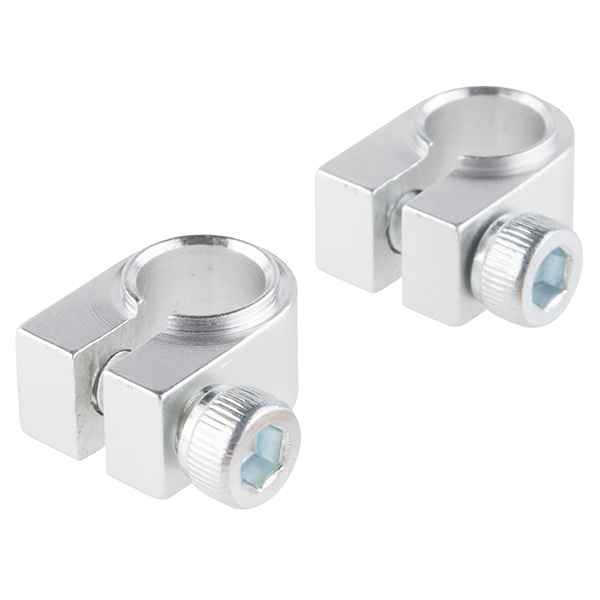
What factors should I consider when choosing a split collar for a specific shaft size?
Choosing the right split collar for a specific shaft size is crucial to ensure a secure and reliable connection. Several factors should be considered during the selection process:
- 1. Shaft Diameter: Measure the diameter of the shaft accurately. The inner diameter of the split collar should match the shaft size precisely to ensure a proper fit and grip.
- 2. Collar Material: Select a collar made from a material suitable for your application. Common materials include steel, aluminum, and stainless steel. Consider factors such as strength, corrosion resistance, and environmental compatibility.
- 3. Shaft Material: The material of the shaft is important, as it affects compatibility with the collar material. Ensure that the collar material is compatible with the shaft material to prevent galvanic corrosion or excessive wear.
- 4. Environmental Conditions: Consider the operating environment. If the application is exposed to moisture, chemicals, or extreme temperatures, choose a collar with the appropriate corrosion resistance and environmental seals if necessary.
- 5. Load and Torque: Determine the load and torque requirements of your application. Select a split collar that can handle the expected forces without deforming or slipping on the shaft.
- 6. Collar Type: Choose the appropriate collar type, such as a single-split or double-split collar, based on your application’s requirements. Double-split collars provide greater holding power but may require more space on the shaft.
- 7. Locking Mechanism: Different split collars use various locking mechanisms, including set screws, clamping screws, or levers. Consider the ease of installation and removal, and the effectiveness of the locking mechanism for your application.
- 8. Space Limitations: Evaluate the available space on the shaft. Ensure that the split collar can be installed without interference from adjacent components or other collars on the same shaft.
- 9. Reusability: Determine if the split collar needs to be reusable. Some collars can be removed and reinstalled multiple times, while others may be designed for permanent installations.
- 10. Precision Requirements: For applications requiring precise positioning, choose a split collar with tight tolerances and accurate machining to ensure proper alignment of components.
- 11. Special Features: Some split collars offer additional features, such as vibration damping, environmental sealing, or keyways. Assess whether these features are necessary for your application.
- 12. Budget Constraints: Consider your budget and the cost of the split collar. While quality is essential, it’s important to find a balance between performance and cost-effectiveness.
By taking these factors into account, you can make an informed decision when choosing a split collar that suits your specific shaft size and application requirements.


editor by CX 2023-11-08
China 8PCS Drill Stop Assortment Drill Depth Stop Collars Limit Ring Dowel Shaft Chuck Positioner Locator for Drill Bits Consistent axle collar bearing
Warranty: 1year
Customized support: OEM, ODM
Type: Twist Drill Bit
Use: Wood Drilling
Finish: Black Oxide
Product name: Drill Stop Collar Set
Material: High Carbon Steel
Usage: Wood Drillimg
Size: 3-16mm
Color: Balck
Packing: Plastic Bag
MOQ: 1 4WG2 South America(30.00%),Africa(20.00%),North America(10.00%). There are total about 1-4 people in our office.2. how can we guarantee quality?Always a pre-production sample before mass production;Always final Inspection before shipment;3.what can you buy from us?Hardware,Construction & Real Estate4. why should you buy from us not from other suppliers?HangZhou Chevalierous Machinery Electrical Equipment Co.Ltd. is a leading company with more than 10 years’ full export and import experience, which delivers quality and price competitive products to many countries, mostly to Europe and USA.5. what services can we provide?Accepted Delivery Terms: FOB,CFR,CIF,EXW,DDP,DDU,Express Delivery;Accepted Payment Currency:USD,EUR,CNY;Accepted Payment Type: T/T,L/C,D/P D/A,PayPal,Western Union;Language Spoken:English,Chinese,Spanish,German,French
Choosing a Shaft Collar
The shaft collar is a simple machine component used in a variety of power transmission applications. They are most often found on gearboxes and motors. Their simple design makes them an easy component to install and remove. Among other uses, shaft collars are used as bearing faces, mechanical stops, and locating components.
Clamp-style shaft collars
Clamp-style shaft collars fix many of the problems associated with set-screw collars. Available in two-piece and one-piece designs, these collars compress the shaft and lock into place. This allows for a uniform distribution of force on the shaft. Clamp-style shaft collars provide more holding power than set-screw collars, but they work best under consistent pressure. Clamp-style shaft collars also work better against negative forces, as they have a separate, un-tightened side.
Clamp-style shaft collars feature mounting holes in the outer diameter. Like clamp-style collars, mountable shaft collars can be installed on adjacent assemblies, but the mounting method does not affect holding power. Mountable shaft collars are commonly used in mounting sensor brackets. They may have rounded or flat outer diameters to accommodate the mounting process. Mountable shaft collars may also have tapped or flat holes to facilitate installation.
Quick-clamp shaft collars have the same functionality as clamp-style collars, but feature a removable lever. They are typically quick-to-install and do not mar the shaft. Quick-clamping collars are especially beneficial in applications that require light-duty torque. They also make for quick and easy adjustments.
Heavy-duty shaft collars feature larger outer diameters, a wider face, and a larger screw. These collars are ideally suited for d-shafting and can offer greater holding power than set-screw collars. These collars are typically manufactured from high-strength 2024 aluminum.
Clamp-style shaft collars can be used in many different applications. They can be used for a variety of applications, including bearings, and are especially suited for rotary machines. However, there are some drawbacks. While they may not be as flexible as set-screw collars, they can still perform well under constant loads. One drawback is that they tend to loosen under shocks and reduce the holding power of clamping hardware.
Another advantage of clamp-style shaft collars is that they do not mar the shaft and allow for easy positioning adjustments. Furthermore, they are easier to install and offer greater holding power than set-screw collars. These collars are made from high-quality materials with tight tolerances and are available in different bore sizes.
Clamp-style shaft collars are the most common type of shaft collars. They can be two-piece or one-piece. Among these, two-piece collars are the most convenient option. One-piece collars are hard to move, and two-piece collars have a hinge on one side and a clamp-style collar on the other side.
The materials used in Clamp-style shaft collars play a crucial role in their overall performance. They should be strong, corrosion-resistant, and have good holding power. They should also be able to withstand high temperatures. The most common materials used for shaft collars are steel and aluminum. Some types are made from stainless steel, while others are made from engineered plastic.
Clamp-style shaft collars can come in two pieces or single-piece designs. The smaller one-piece collars usually have a back-cut opposite the clamp cut, which reduces the cross-sectional area at the hinge point. This reduces the amount of force required to clamp the collar, which makes it easier to use stronger screws.
Aluminum, carbon steel, and stainless steel shaft collars
When choosing a shaft collar, you should consider the material it is made of. You can purchase collars made of carbon steel, aluminum, or stainless steel. Each of these materials has its benefits and disadvantages. Steel is more durable than aluminum and tends to provide better holding power. Aluminum, on the other hand, is lighter and has a favorable strength-to-weight ratio. The material you choose should depend on your specific needs, such as corrosion resistance or weight.
Mountable shaft collars are used to mount sensors, fixtures, and other assemblies. These collars are available with outer diameter holes, flats, or quick-release designs. The material used to make these collars varies, with standard models made of 1215 lead-free steel and 2024 aluminum.
When choosing shaft collars, take into account the material and surface treatment. Different materials offer different properties, which will determine the performance of the collar. In addition to material, each shaft collar comes with a different holding power. Holding power is a key factor in choosing a shaft collar because it determines the amount of load it can withstand without slipping. The holding power depends on the screw size, the bore size, and the bulk of the collar.
Aluminum, carbon steel, and stainless steel shaft-collars can come in various styles. CZPT, for example, offers standard shaft collars in hex and d-bore profiles. Hex collars provide extra holding power and are better than set screws. Additionally, they do not mar the shaft and provide a better grip.
Another type of shaft collar is the quick-clamp shaft collar. These features allow users to install and remove them with ease. The quick-clamp collar has a handle that allows the user to quickly adjust it. While these shaft collars are designed for light duty applications, they are not recommended for heavy-duty or high-RPM applications.
Shaft collars are simple yet versatile components. They are used for various applications, including mechanical stops, stroke limiters, and retainers. They can also be used to align and space other components. Shaft collars are widely used in gearbox assemblies, flagpoles, and medical instruments, among others.
Two-piece shaft collars offer the same benefits of one-piece shaft collars, but offer additional convenience and versatility. They are easier to install and disassemble, reducing installation and labor costs. They also offer superior holding power. They also feature a threaded bore that acts as a positive mechanical stop when the shaft is rotated.
Over-torqueing shaft collars
Shaft collars are often used to secure components on shafts or other surfaces. They also provide an easy way to adjust the positioning of motor assembly components. Many different types of shaft collars are available to meet the specific needs of different applications. These include round, hexagonal, square, and D-bore collars.
The design of shaft collars must account for the load they will support. Some collars are made of metals, while others are made of plastic or composite materials. Typically, shaft collars are made of steel, but can also be made from aluminum or alloyed steel. Some are coated with zinc.
Shaft collars are available in one-piece and two-piece designs. Single-piece collars are designed to fit securely around a shaft, while double-piece collars allow for greater clamping force. These collars can be assembled anywhere along the shaft and can be installed between two pieces. They are available in different bore configurations and can be customized to meet your specific application.
Clamp style collars are easy to install and disassemble, and have a larger holding force than one-piece collars. These collars are also more shock-load resistant. They also don’t mar shaft surfaces, unlike setscrews. They can also be easily adjusted without damaging the shaft. Another style of collar is the quick-clamping style. This type of collar doesn’t mar the shaft, and is easily installed and removed without tools. These are best for light-duty applications.
When choosing a shaft collar, you should consider the tolerance of the shaft. It is important to select a shaft with a tight tolerance. The shaft’s hardness should not be greater than Rockwell C35. A wide tolerance will affect the holding power of the collar. If the shaft is undersized, you may need to use a screwdrive to slide the collar on the shaft.
Shaft collars are a versatile component with many different applications. They can secure industrial railings or serve as positioning devices in medical equipment. They are also widely used in automation machinery. They are used to protect cylinders and actuators and to ensure alignment between components. For this reason, they are very versatile and adaptable.
Clamp-style collars work well under constant loads, but they may need assistance during impact loads. Shock loads can be difficult to avoid, especially if the mass is small. Clamp-style collars with an undercut in the shaft help to resist the impact of shock. Moreover, they offer positive stops in both axial directions.
Clamp-style shaft collars are a good alternative for set-screw collars. They are easy to install and prevent shaft damage. They also come with an added advantage of being easy to adjust. Clamp-style shaft collars have double the holding power of set-screw collars.
In addition to holding components, shaft collars can also function as spacers and limit shaft movement. They are essential for many applications. They are commonly used in motors and gearboxes to ensure correct positioning for power transmission. They are also used to control shaft movement in reciprocating applications.

editor by czh2023-02-16
China Spring Steel Retaining Washers for Shaft, Internal Tooth Rings Starlock Washers, Push on Quick Lock Shaft Clips, Bearing Clip aluminium shaft collar
Item Description
Merchandise Description
| Product Title | Shaft Star Lock Washer |
| Materials | Carbon Metal |
| Neutral Dimension | ∅2 /∅3 /∅4 /∅5 /∅6 /∅8 /∅10 /∅12 |
| Intercontinental Common | GB96-eighty five |
| OEM/ODM Support | Available |
| Do it yourself Subpackage Support for Retails Proprietor Buy (Like Amazon Seller) | Available |
| Guide Time for Generation | Depends on your get contents |
| Payment Phrase | Negotiable |
Product Parameters
The drawing and datasheet of High Strength Thrust on Shaft Star Lock Washer GB96-85 as beneath:
We provide size from ∅2 to ∅12 to meet your distinct specifications, Or your requirements is outside of our regular requirements. Deliver us your drawing to examine a lot more particulars to be sastified your enquiry then.
* Notes: Measurement by manual, various batch have a lot of big difference in tolerance variety. If exact benefit is crucial element based on your requirement. Come to feel totally free contact our sales rep. to Verified.
Connected Items
Except High Toughness Press on Shaft Star Lock Washer GB96-eighty five, We have one more varieties of washer to serve all of you. Welcome to ship us your enquiry for distinct products.
More Goods
Besides Circlip, Washer and Gasket, We provided Screw, Nuts/Nails, Clamp and another hardware accessories etc. Neutral Dimensions or OEM Provider are obtainable over there.
Company Profile
Our oversea revenue workplace is found in HangZhou City, ZheJiang & HangZhou ZheJiang , and sourcing office & warehouse was situated in HangZhou Metropolis, ZheJiang . All orders of yours would be transported out from Warehouse in HangZhou.
If the purchase has been put and comfirmed, FOB Xihu (West Lake) Dis. ports or Any Chinese Port is workable with us.
By the way, we can served storage provider and sub-deal service from your true requirement.
Any queries you have textual content us or ship us inquiry before long.
Remember to do not hesitated…
Payment, Cargo and About Us
Now, for payment strategies and cargo way what you concorned, check out the postcast as underneath to figure it out. Or much more particulars make sure you permit us to introduce our sales consultant Mr.Alvin Wong to all of you.
One particular much more point, Pay far more attention to our major goods: Screws, Nuts/Nails, Washer/Gasket, Clamp and yet another components add-ons and many others. remember to.
Thank you so a lot!
|
US $0.01-0.2 / Piece | |
10,000 Pieces (Min. Order) |
###
|
Shipping Cost:
Estimated freight per unit. |
To be negotiated| Freight Cost Calculator |
|---|
###
| Type: | Lock Washer |
|---|---|
| Material: | Carbon Steel |
| Combination Washer Structure: | Circlip |
###
| Samples: |
US$ 0/Piece
1 Piece(Min.Order) |
|---|
###
| Customization: |
Available
|
|---|
###
| Product Name | Shaft Star Lock Washer |
| Materials | Carbon Steel |
| Neutral Size | ∅2 /∅3 /∅4 /∅5 /∅6 /∅8 /∅10 /∅12 |
| International Standard | GB96-85 |
| OEM/ODM Service | Available |
| DIY Subpackage Service for Retails Owner Order (Like Amazon Seller) | Available |
| Lead Time for Production | Depends on your order contents |
| Payment Term | Negotiable |
|
US $0.01-0.2 / Piece | |
10,000 Pieces (Min. Order) |
###
|
Shipping Cost:
Estimated freight per unit. |
To be negotiated| Freight Cost Calculator |
|---|
###
| Type: | Lock Washer |
|---|---|
| Material: | Carbon Steel |
| Combination Washer Structure: | Circlip |
###
| Samples: |
US$ 0/Piece
1 Piece(Min.Order) |
|---|
###
| Customization: |
Available
|
|---|
###
| Product Name | Shaft Star Lock Washer |
| Materials | Carbon Steel |
| Neutral Size | ∅2 /∅3 /∅4 /∅5 /∅6 /∅8 /∅10 /∅12 |
| International Standard | GB96-85 |
| OEM/ODM Service | Available |
| DIY Subpackage Service for Retails Owner Order (Like Amazon Seller) | Available |
| Lead Time for Production | Depends on your order contents |
| Payment Term | Negotiable |
Types of Shaft Collars
Clamp style shaft collars
A variety of styles of shaft collars are available for your machining needs. Clamp style shaft collars offer better flexibility and hold better than set screw collars. They are best for shaft materials that are softer than a setscrew. Clamp style collars are generally easier to maneuver, as they are two-piece and are hinged along the shaft.
Clamp style shaft collars come in two-piece and one-piece designs. One-piece clamp collars are typically used for a single-piece shaft, while two-piece clamp collars are used for multiple shafts. The one-piece clamp collar provides a more uniform holding force, while two-piece clamp collars provide more clamping force and can be installed anywhere on the shaft. Both styles are available in English and metric measurements.
The holding power of Clamp style shaft collars depends on their bore size and concentricity. The fastening hardware also affects torque transmission. Forged screws are generally stronger than broached screws, and are less likely to ream out. However, you still need to make sure that the material of the collar is strong enough to withstand the recommended screw torque.
Clamp style shaft collars are available in 1215 lead-free steel with a black oxide finish and zinc plating, as well as 303 and 316 stainless steel. They are also available in 2024 aluminum with an anodized finish. They are available in a range of sizes from 1/8” to six inches and 3mm to 150mm.
One of the main benefits of Clamp style shaft collars is their versatility. The collars can be used as guides, spacers, or stops on a variety of medical equipment. They are designed to distribute compression forces around a shaft, and they can be added at any stage in the manufacturing process.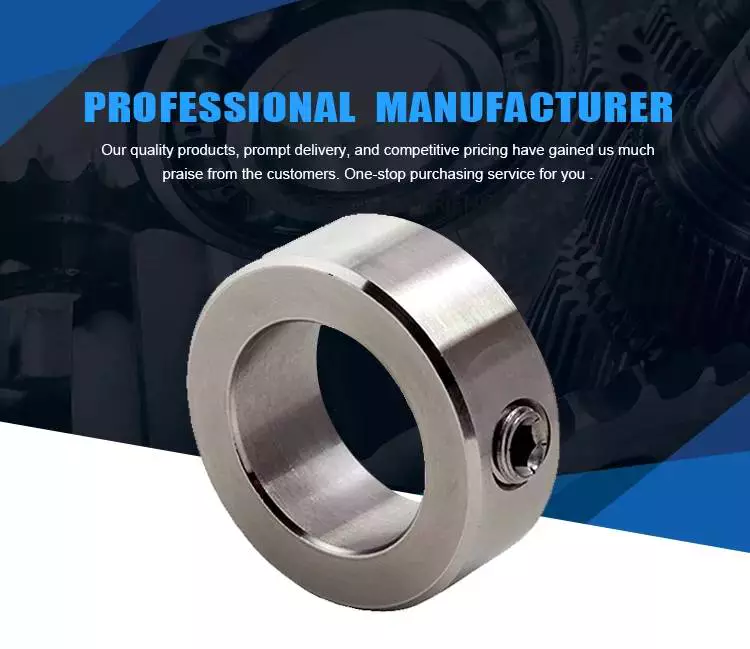
Set screw shaft collars
Set screw shaft collars are used to secure screws to shafts. They can be purchased in a variety of sizes. The external diameter, internal diameter, and width of the collar will determine the proper collar size. Some companies also offer custom and adjustable-width collars. Clamp-style shaft collars are easier to maintain, and distribute torque evenly across the shaft. They also offer twice the holding power of set screw collars.
Collars are available in metric and inch sizes. They are also available in zinc plated and black-oxide steel. In addition, they come in a variety of styles. Whether you’re looking for a custom collar, or something a little more conventional, you can find it with the help of an ISO-certified supplier.
Set screw shaft collars come in different sizes and materials. Socket collars, for example, are made of steel and have an inside diameter of 5/64″ to 1-1/8″. In addition, forged socket set screw shaft collars come in 3/16 to 4 in. They are also available with special hardware for connection to shafts.
Set screw shaft collars are commonly used on transmission and machinery. A set screw allows you to secure the collar in position by setting it into the correct position with a grub screw or a set screw. The set screw can then be adjusted with a screw driver and is a quick and easy solution for keeping a shaft in place.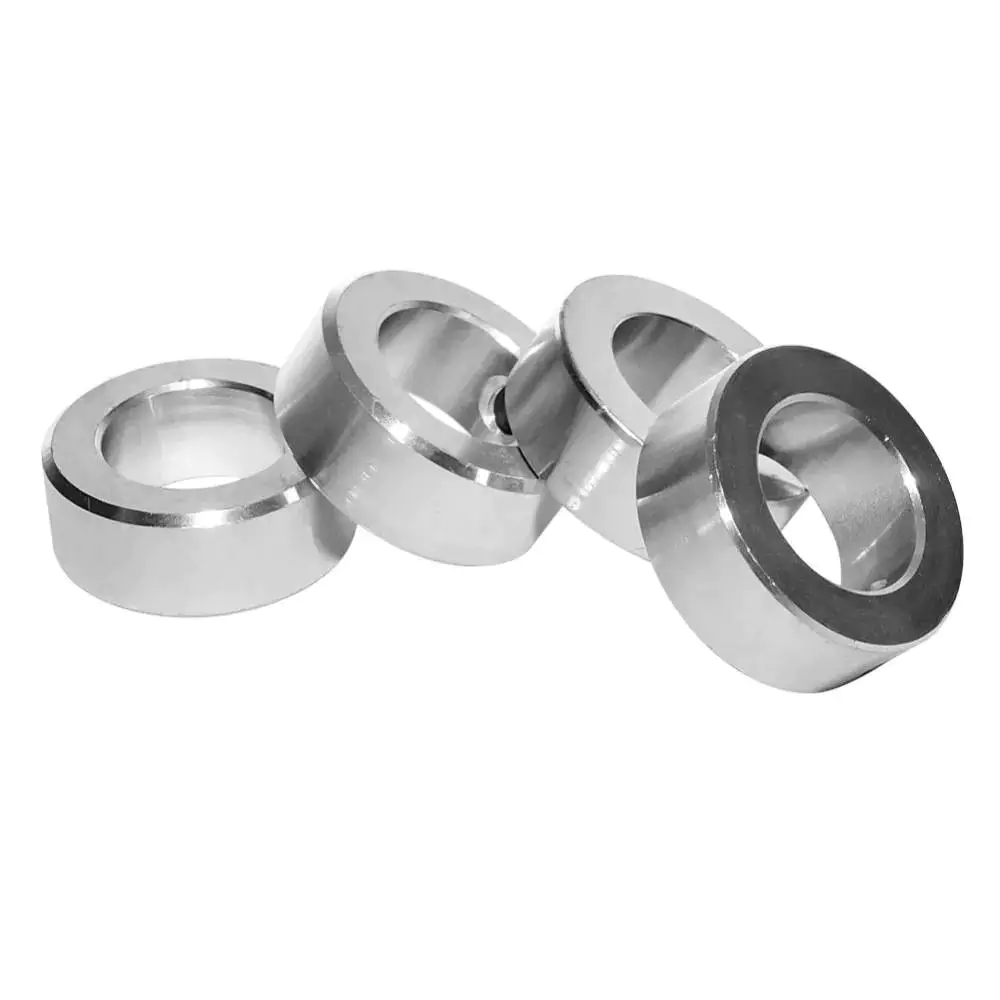
Aluminum shaft collars
Aluminum shaft collars offer a number of advantages, ranging from their light weight to their corrosion resistance. Aluminum shaft collars are available in various styles and sizes, and can be plated with a variety of finishes. They are also available in lightweight styles for applications with tight space constraints. The most important factor when selecting a shaft collar is the material used to make it. Aluminum is lighter than steel and has a high strength to weight ratio. The choice of material should also depend on how much corrosion resistance is required. For example, if the shaft will be exposed to extreme environments, it is a better choice to use treated steel.
Another benefit to aluminum shaft collars is their ability to be custom-matched to the shaft. This feature helps to increase their aesthetics and branding potential. In addition, the ability to color-code components and switches can improve safety. This is especially useful in fail-safe applications. By incorporating color-coded collars, manufacturers can increase the safety of their products.
Another advantage of aluminum shaft collars is their strength. For instance, they can withstand higher torque levels than other types of shaft collars. They can be easily adjusted, and their two-piece design makes them easy to replace. Moreover, CZPT keeps the two-piece collars together during manufacturing, ensuring a perfect fit for the shaft. These collars also feature forged steel socket screws for enhanced holding power and torque capacity.
Single-piece shaft collars are also available in various styles. The set screw type has a perpendicular outer face. The set screw in these collars is used to engage the mating shaft. This type of shaft collar is a good choice for rotating assemblies.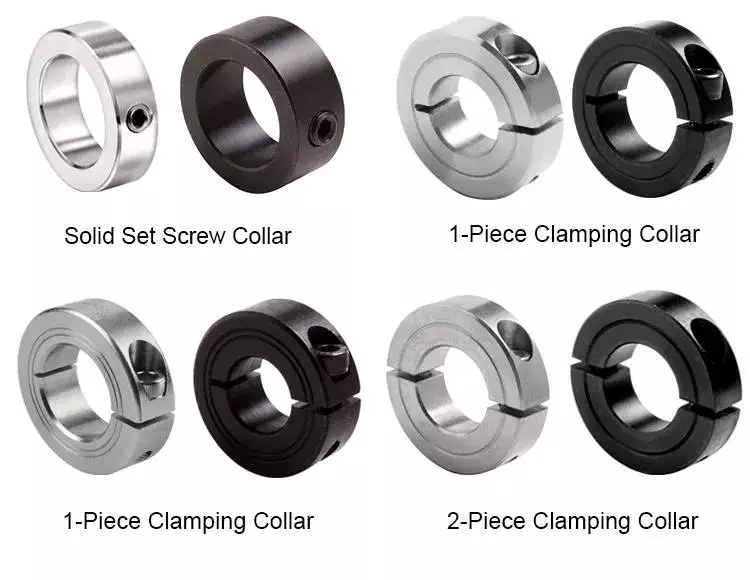
Stainless steel shaft collars
The main function of a stainless steel shaft collar is to provide clamping force to a rotating shaft. This is achieved by a variety of methods. One of these is by bending or hammering. A shaft collar can also be made of aluminum or a combination of both. These options provide different advantages, which are described in this article.
Stainless steel shaft collars are available in different sizes, shapes, and materials. The diameter of the shaft collar may range from five-sixteenths to two-and-a-half inches. Some manufacturers produce the collars in different materials, including T304, T316, 416, and 17-4PH. Their products may also come in various shapes, such as angles, flats, structural shapes, and threaded rods.
One of the most important advantages of a stainless steel shaft collar is its strength and durability. A well-made collar can prevent wear and tear and provide excellent holding power. It also has many applications and is useful in many industries. Its application ranges from vertical conveyors to horizontal athletic equipment machinery, from agriculture to retail.
While there are numerous types of shaft collars, all three types have some common characteristics. Typically, steel shaft collars have high holding power and slim to average profiles. Heavy-duty collars have twice the holding power of low-profile collars and are used in heavy-duty construction and mining. Ultra Heavy-Duty shaft collars have the highest axial holding power and are made of steel. Shaft collars may be treated with zinc for corrosion resistance.
One manufacturer offers stainless steel shaft collars made of 303 stainless steel and other materials. It offers collars of various diameters from three-eighth to one-eighth inch. They are available in threaded, mounting, and heavy-duty styles, and are suitable for a wide range of applications, including the aerospace, energy, and medical industries.

editor by czh 2022-12-22